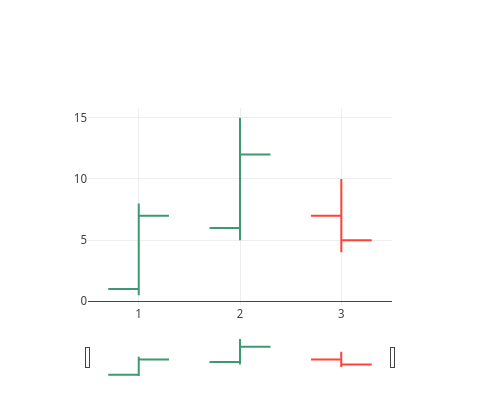NAME
Chart::Plotly::Trace::Ohlc - The ohlc (short for Open-High-Low-Close) is a style of financial chart describing open, high, low and close for a given `x` coordinate (most likely time). The tip of the lines represent the `low` and `high` values and the horizontal segments represent the `open` and `close` values. Sample points where the close value is higher (lower) then the open value are called increasing (decreasing). By default, increasing items are drawn in green whereas decreasing are drawn in red.
VERSION
version 0.022
SYNOPSIS
use Chart::Plotly;
use Chart::Plotly::Trace::Ohlc;
my $ohlc = Chart::Plotly::Trace::Ohlc->new(
x => [ 1 .. 5 ],
open => [ 1, 6, 7 ],
close => [ 7, 12, 5 ],
high => [ 8, 15, 10 ],
low => [ 0.5, 5, 4 ]
);
Chart::Plotly::show_plot([ $ohlc ]);DESCRIPTION
The ohlc (short for Open-High-Low-Close) is a style of financial chart describing open, high, low and close for a given `x` coordinate (most likely time). The tip of the lines represent the `low` and `high` values and the horizontal segments represent the `open` and `close` values. Sample points where the close value is higher (lower) then the open value are called increasing (decreasing). By default, increasing items are drawn in green whereas decreasing are drawn in red.
Screenshot of the above example:

This file has been autogenerated from the official plotly.js source.
If you like Plotly, please support them: https://plot.ly/ Open source announcement: https://plot.ly/javascript/open-source-announcement/
Full reference: https://plot.ly/javascript/reference/#ohlc
DISCLAIMER
This is an unofficial Plotly Perl module. Currently I'm not affiliated in any way with Plotly. But I think plotly.js is a great library and I want to use it with perl.
METHODS
TO_JSON
Serialize the trace to JSON. This method should be called only by JSON serializer.
type
Trace type.
ATTRIBUTES
close
Sets the close values.
closesrc
Sets the source reference on plot.ly for close .
customdata
Assigns extra data each datum. This may be useful when listening to hover, click and selection events. Note that, *scatter* traces also appends customdata items in the markers DOM elements
customdatasrc
Sets the source reference on plot.ly for customdata .
decreasing
high
Sets the high values.
highsrc
Sets the source reference on plot.ly for high .
hoverinfo
Determines which trace information appear on hover. If `none` or `skip` are set, no information is displayed upon hovering. But, if `none` is set, click and hover events are still fired.
hoverinfosrc
Sets the source reference on plot.ly for hoverinfo .
hoverlabel
ids
Assigns id labels to each datum. These ids for object constancy of data points during animation. Should be an array of strings, not numbers or any other type.
idssrc
Sets the source reference on plot.ly for ids .
increasing
legendgroup
Sets the legend group for this trace. Traces part of the same legend group hide/show at the same time when toggling legend items.
line
low
Sets the low values.
lowsrc
Sets the source reference on plot.ly for low .
name
Sets the trace name. The trace name appear as the legend item and on hover.
opacity
Sets the opacity of the trace.
open
Sets the open values.
opensrc
Sets the source reference on plot.ly for open .
selectedpoints
Array containing integer indices of selected points. Has an effect only for traces that support selections. Note that an empty array means an empty selection where the `unselected` are turned on for all points, whereas, any other non-array values means no selection all where the `selected` and `unselected` styles have no effect.
showlegend
Determines whether or not an item corresponding to this trace is shown in the legend.
stream
text
Sets hover text elements associated with each sample point. If a single string, the same string appears over all the data points. If an array of string, the items are mapped in order to this trace's sample points.
textsrc
Sets the source reference on plot.ly for text .
tickwidth
Sets the width of the open/close tick marks relative to the *x* minimal interval.
transforms
uid
uirevision
Controls persistence of some user-driven changes to the trace: `constraintrange` in `parcoords` traces, as well as some `editable: true` modifications such as `name` and `colorbar.title`. Defaults to `layout.uirevision`. Note that other user-driven trace attribute changes are controlled by `layout` attributes: `trace.visible` is controlled by `layout.legend.uirevision`, `selectedpoints` is controlled by `layout.selectionrevision`, and `colorbar.(x|y)` (accessible with `config: {editable: true}`) is controlled by `layout.editrevision`. Trace changes are tracked by `uid`, which only falls back on trace index if no `uid` is provided. So if your app can add/remove traces before the end of the `data` array, such that the same trace has a different index, you can still preserve user-driven changes if you give each trace a `uid` that stays with it as it moves.
visible
Determines whether or not this trace is visible. If *legendonly*, the trace is not drawn, but can appear as a legend item (provided that the legend itself is visible).
x
Sets the x coordinates. If absent, linear coordinate will be generated.
xaxis
Sets a reference between this trace's x coordinates and a 2D cartesian x axis. If *x* (the default value), the x coordinates refer to `layout.xaxis`. If *x2*, the x coordinates refer to `layout.xaxis2`, and so on.
xcalendar
Sets the calendar system to use with `x` date data.
xsrc
Sets the source reference on plot.ly for x .
yaxis
Sets a reference between this trace's y coordinates and a 2D cartesian y axis. If *y* (the default value), the y coordinates refer to `layout.yaxis`. If *y2*, the y coordinates refer to `layout.yaxis2`, and so on.
AUTHOR
Pablo Rodríguez González <pablo.rodriguez.gonzalez@gmail.com>
COPYRIGHT AND LICENSE
This software is Copyright (c) 2018 by Pablo Rodríguez González.
This is free software, licensed under:
The MIT (X11) License